Personalized Curriculum & Instruction
Staffing & Professional Development
Curriculum & Instruction: Promoting Independence in Social Interactions
The Bridge School
Programs, Strategies and Perspectives – Setting the standard
more info
Communicative Competence with AAC – – Skill areas and strategies for developing proficiency in use of AAC
Self-Determination Program – Developing critical self-advocacy and independence skills
more info
The Bridge School
Programs, Strategies and Perspectives – Setting the standard
more info
The Bridge School Course of Study
The Bridge School
Programs, Strategies and Perspectives – Setting the standard
more info
Instruction in English-Language Arts (ELA) encompasses a growing appreciation and knowledge of language and literature through the intertwined processes of speaking, reading, listening, spelling and writing. Language and literacy development is important for all students for personal, social and academic success. For students with severe speech and physical impairments (SSPI), language and literacy instruction is particularly critical for accessing communication modalities and informational resources across the lifespan.
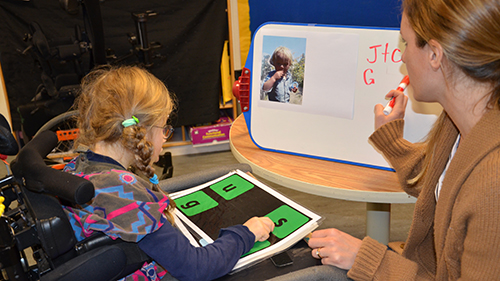
Students with limited natural speech may not have had experience experimenting with sounds of spoken language or asking questions to gain information about the world around them and the words they hear. When students have SSPI, they may have had limited early literacy experiences with picture books or printed text, due to their inability to independently manipulate books and difficulties encountered by others while trying to hold or position a book in ways that the child can see it, turn pages and interact during book reading activities. Students with restricted mobility may have had limited experiences manipulating objects and exploring environments which could impact their ability to meaningfully comprehend words they hear or see in a story or in informational text.
A broad view of literacy considers the ability to obtain and use information from the environment through a variety of modes for a variety of purposes such as obtaining desired items or actions, making choices and decisions or gaining information and demonstrating knowledge. ELA instruction may focus on visual literacy, sight word recognition and/or conventional literacy using phonics instruction. Visual literacy entails discerning meaning from photos, pictures, logos and videos. Sight word recognition is taught through carefully selected, relevant or commonly encountered printed words from daily life such as labels or signs in the environment. These kinds of literacy skills are important in building knowledge, providing access to vocabulary for augmentative and alternative communication (AAC) systems, structuring daily routines and engaging in picture book reading. However, for a student to become conventionally literate, phonics instruction is needed. Phonetic decoding allows students to learn to read words based on letter-sound or syllable-sound correspondence and blending. Reading instruction at The Bridge School places equal emphasis on the sophistication of what students read and the skill with which they read.
At The Bridge School, our teachers and SLPs carefully assess each student’s language and literacy skills and design individualized instruction that includes accommodations to address challenges of ELA instruction and learning by students with SSPI. We introduce accommodations such as AAC tools and devices, adaptations of printed materials, environmental arrangements and workstation set-ups for instruction in key areas of reading, phonics, writing and vocabulary comprehension.
Phonics instruction explicitly and systematically teaches students to relate sounds to letters of the alphabet, break spoken words and text into sounds, and blend sounds to form words. Our teachers adapt instruction and provide accommodations as they teach students to apply this knowledge of letters and sounds as they read words, sentences and connected text. Many Bridge School students are unable to produce approximations of letters and sounds, therefore, our teachers use adapted phonics instruction and guided practice that encourage students to use internal speech and/or physical movements to indicate their engagement in the decoding process.
Accommodations are also made for students with cortical visual impairment (CVI). These accommodations may include using light boxes that provide back lighting for objects or documents, dimming environmental lighting, placing objects, letters and words on a black background, worksheets adapted with “glow writing” and placed on a light box, positioning an object or text in the student’s preferred visual field, enlarging and simplifying text or objects and/or verbally describing the salient features of objects, letters or words.

Abigail practices one-to-one letter-sound correspondences by pointing to letters on a frequency-ordered low-tech alphabet board to write a caption for a photograph. Having multiple opportunities to practice learning the sound of the letter and its location on the communication board is the first step to becoming proficient writing with letters. Here she dictates letters to her teacher. As she becomes more competent, she’ll complete the task independently by writing directly to a computer and word document.
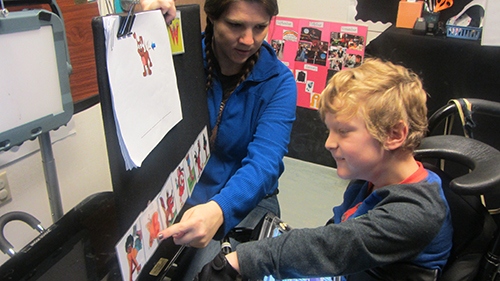
Jet is learning to become more independent finding initial consonant, medial vowel, and final sounds in three-phoneme words using picture/letter cards that cue him to the letter sounds without his teacher’s help. The letters are evenly spaced under the picture of the word so that it’s easier for Jet to see and indicate his choice to his teacher as she silently points to each letter. As he chooses his letters, his teacher moves them to the top of the board. When the word is complete, his teacher allows Jet time to blend the letters to read the word.
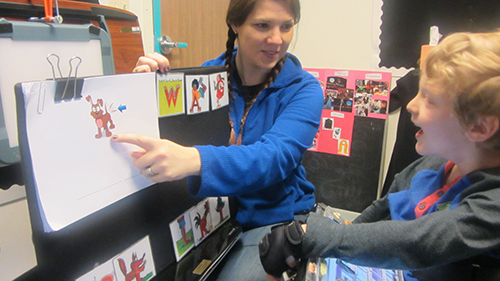
As you can see from his facial expression, Jet is very pleased with the fact that he’s spelled the word ‘wag’ all by himself!
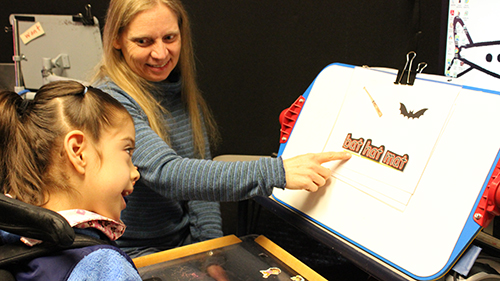
Students are given multiple opportunities to practice blending and segmenting onsets and rhymes of single-syllable spoken words. Here, Jackie’s teacher is modeling how to blend sounds to find the correct word to match its picture. Jackie can’t say the sounds or blend the onset and rhyme out loud, but she is being taught how she can use the inner voice in her head to say the sounds as her teacher models. Accommodations to the text and pictures follow cortical visual intervention guidelines.
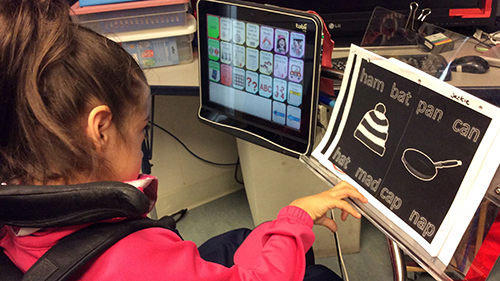
Jackie uses a switch to scan to the picture of a hat on her SGD. When she finds and selects it, the word, ‘hat’ will be said aloud. Hearing the sounds in the word will help her decode and pick the matching written word on her worksheet. This is one strategy that supports Jackie becoming more independent when decoding. In addition to using her SGD to support her reading, text and pictures on her worksheet are enlarged and simplified. The worksheet itself is placed on a specially designed document holder that attaches to Jackie’s SGD mounting pole and this makes it easier for her to split her visual attention between her worksheet and her SGD.
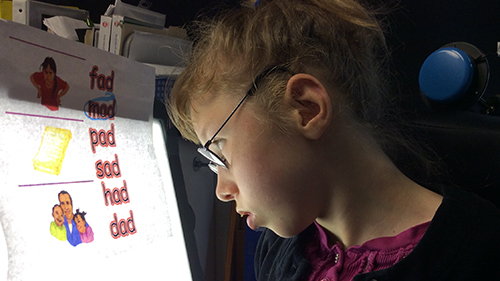
Abigail relies on visual accommodations to support her decoding of onsets and rhymes. Worksheets adapted with ‘glow writing’ are placed on a light box, positioned in her preferred visual field, and the lights in the room are lowered.
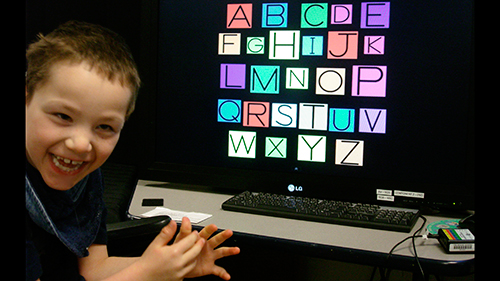
Numerous YouTube phonics videos are used to engage students when they are learning letter sounds. Students respond to the animations, the music and the ability to repeat the video as many times as they like.
All activities and materials are designed to meet the specific needs of individual students. The most common adaptations for reading activities are those for cortical vision impairments (CVI). The examples in these photos will show various strategies and tools we have found useful. Communication goals and objectives are infused into the educational curriculum so that multiple objectives can be addressed in a single activity. The following examples illustrate how the students use their communication systems to reinforce their educational objectives.
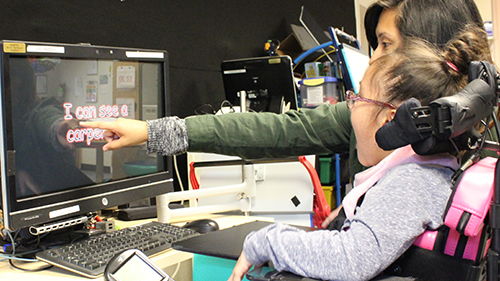
Savannah reads her book on community helpers with text adapted using cortical visual impairment intervention guidelines. The words, written with ‘glow’ letters, are presented on black background, backlit by the computer. The teacher helps Savannah track words by pointing to each word as she reads.
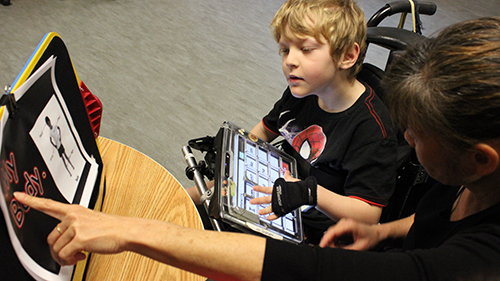
Jet practices reading high frequency sight words found in his community helper book, using his communication device to say the words aloud. This strategy supports both his academic and communication goals. Jet also practices reading without his device and will rely on his inner reading voice to help him build reading fluency.
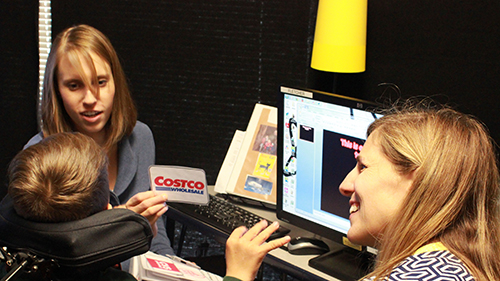
Students are encouraged to read print, pictures, signs, logos, and brand names that they’ll find at school and in their homes and communities. Fletcher is choosing a logo of one of his favorite stores so he can write a shopping list with his mom.
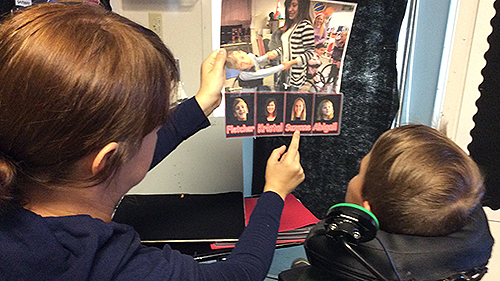
Fletcher is tracking and reading text from left to right by using photos of faces paired with names of people in the large photograph.
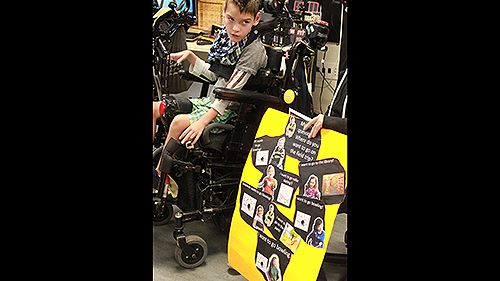
Adam is presenting his weekly survey to his classmates. Individual ‘bubbles’ with students’ pictures and their written opinions are created using a black background PowerPoint slideshow. The pictures and text are printed and pasted on poster board to support Adam’s classmates reading the poster.
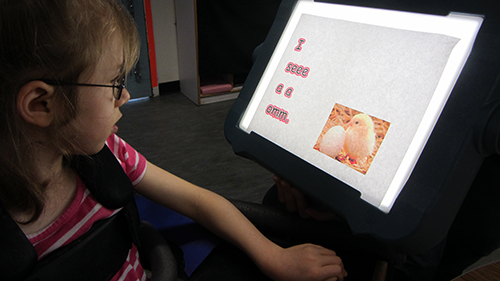
Abigail has finished writing and is re-reading her animal report. She used her high frequency words from her word wall to assist her. Her work is presented on a light box, with enlarged ‘glow’ lettering and a simplified photo.
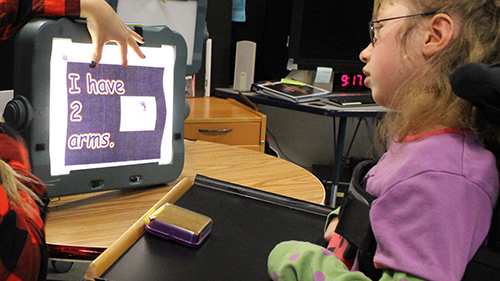
Abigail is independently reading an adapted leveled reader and is encouraged to use her inner reading voice while she reads.
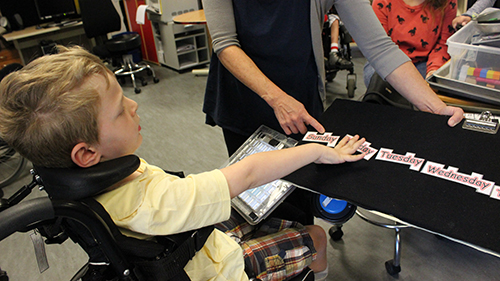
The classroom provides opportunities for reading in all subject areas. Jet is reading the labels to pick the appropriate day for the calendar.
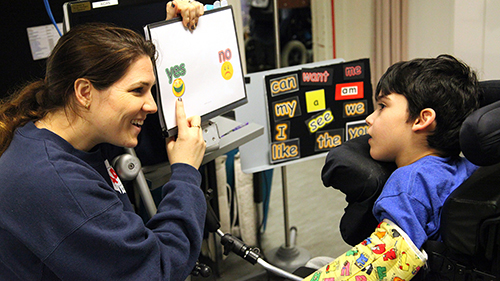
Aidan reads a variety of materials containing pictures and conventional text.
Everyone at The Bridge School writes everyday! We have implemented a comprehensive writing curriculum that provides our students a developmentally sound, sequential pathway to independent writing. The Bridge School staff is particularly creative when it comes to finding the right tools and the most effective strategies to support our students’ writing. A team approach ensures that communication goals as well as educational goals are addressed concurrently and that the students are seated and positioned for optimal participation. Materials and tools are adapted to meet each student’s specific needs. A common AT intervention is a linkage between the student’s SGD and the computer allows them to use a familiar keyboard and access strategy to write. Many of our students have cortical vision impairments and require adapted materials and strategies.
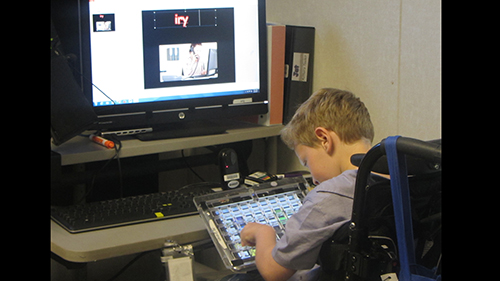
This student is on the road to becoming a conventional writer! He’s given opportunities throughout the school day to share his ideas through written communication using an alphabet keyboard. Today he’s writing an informative piece about his favorite community helper, an office worker. With help from his teacher he’s chosen a picture and now he’s ready to write independently.
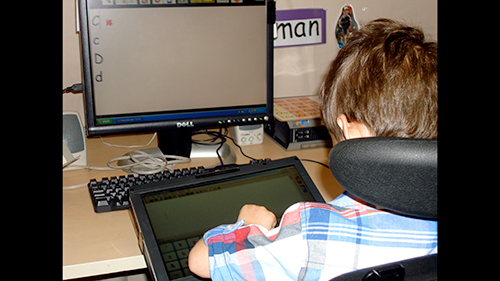
Students who use AAC devices benefit from simple tasks to build operational competence with their alphabet keyboards. Roman is completing the exact same worksheet using his SGD interfaced with his desktop computer as his general education peers do using conventional pencils. Text fields created on Roman’s worksheet allow him to write in the document. And, like his peers, the more proficient he becomes at generating actual letters the more time he has to think about the ideas he wants to share through his writing.
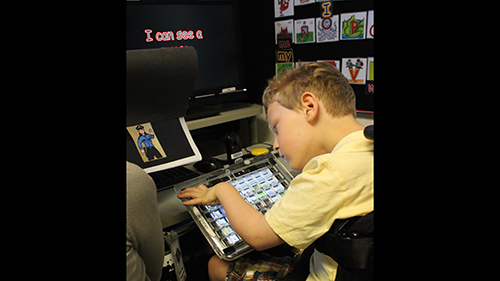
Students communicate through writing for different reasons. For this assignment, Jet is being asked to recall information from a previous lesson so that he can answer the question: ‘Who is this community helper?’ He will finish the sentence, ‘I see a___’ by using his SGD to type on his computer. Visual phonics cards cue him to the sounds of letters and high frequency words are always available on his personal word wall to the right side of his computer.
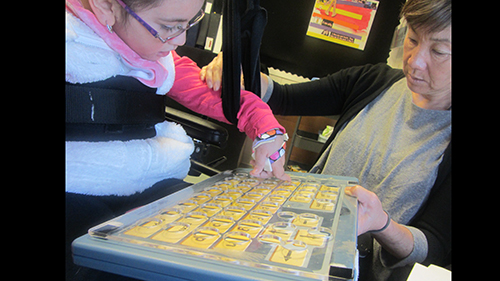
Each student’s access to an alphabet keyboard is unique. Our students can use different modes for writing letters. With movable arm support, Savannah is learning to use her fingers to type on an enlarged alphabet keyboard.
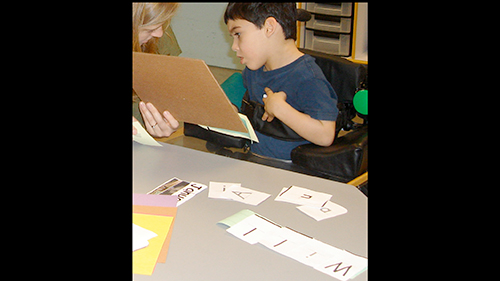
One of Aidan’s ‘pencils’ are letter tiles. He’s getting practice putting the tiles together to spell his and his classmates’ names.
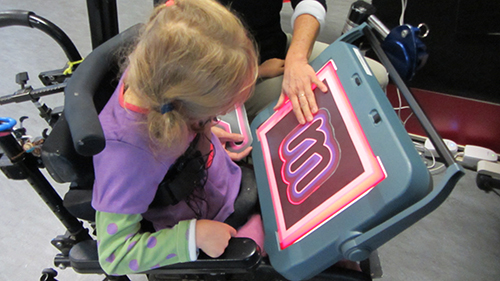
Abigail is using her vision to learn more about the letter ‘m’ using enlarged ‘glow’ letter tiles presented on a light box. This helps her as she transitions to letter tiles and her computer.
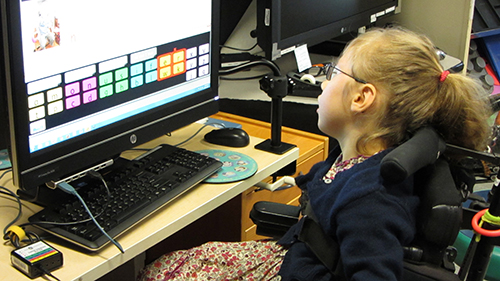
Abigail uses a scanning array on her computer to complete her writing assignment.
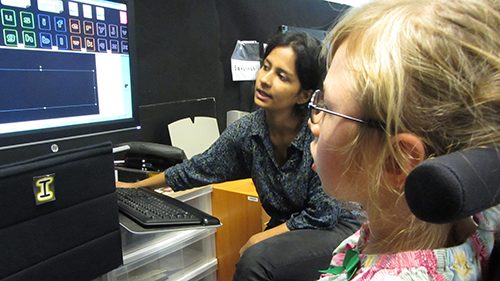
The large, outlined letters on Abigail’s computer screen makes it easier for her to see and access the alphabet for writing.
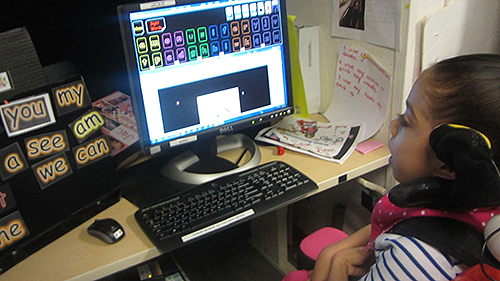
Jackie is reading all the words on her sight word wall and learning to type the first letter of those words using her onscreen alphabet keyboard. As she becomes more proficient, she can eventually use word prediction when writing. This and similar strategies can make writing easier and faster for students using AAC/AT.
Specialized equipment and materials make it possible for Abigail to use her vision to spell, write and read. Displaying the text on a light box, lowering the environmental lights and presenting the target letters with bright colored outlines on a black background all contribute to her success.
Students often learn vocabulary while participating in daily conversations, listening to stories and reading independently. Direct, systematic instruction in vocabulary comprehension is essential for our students because they may not readily learn vocabulary given limited access and opportunities to engage fully in conversations or an inability to ask about the meanings of words. Vocabulary instruction includes focusing on both informational text in a given curricular unit and teaching words and concepts encountered in literature such as storybooks or poems. Our students begin working to build comprehension with prompting and support by answering and asking questions, identifying main ideas and recalling details in stories. In time, students learn to make fuller use of text to determine the meanings of written words using context cues, linking ideas or from learning the meanings of suffixes and prefixes.

Participating in collaborative conversations about literature topics is part of the Common Core curriculum. Students practice speaking with peers and teachers following conversational rules like following an agreed upon topic, commenting on what others say, asking questions, and learning respectful conversational discourse like listening to others and taking turns.
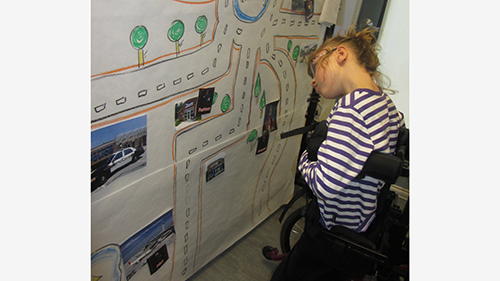
Abigail is learning key details and vocabulary necessary to understand a map illustrating a typical community. Using her hands free walker, she’s able to ambulate and get a close up look at the different areas illustrated by the map. The lesson makes real-life connections to the unit book, ‘Where Do I Live?’ by Neil Chesanow.
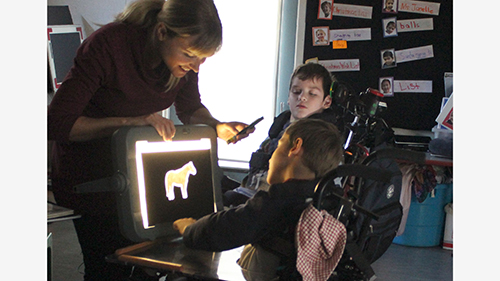
Fletcher’s SLP is teaching key ideas and details using photos adapted for Fletcher’s cortical visual impairment to support multisensory learning during a language arts unit on farm animals. The photos are presented on a light box and a directional light is used to emphasize the important physical details of the horse.

Working independently is an important skill for older students. During a unit exploring the characteristics and relationships of families, Aidan is participating in independent self-selected reading and enjoying a book about a family using Raz-Kids, an online reading program. He follows along as the book is read aloud on the computer.
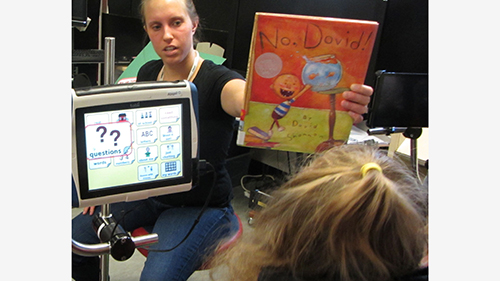
Asking and answering questions about details found in literature selections is required in second grade. Using her speech generating device, Abigail asks a question about the book ‘No, David’ by David Shannon.
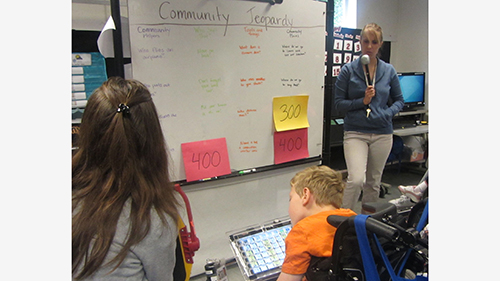
Students play a highly motivating game of Jeopardy while recalling main ideas from their unit on communities. A toy microphone encourages the students to use their SGDs to speak out loud to the group. Jet is searching for his answer.
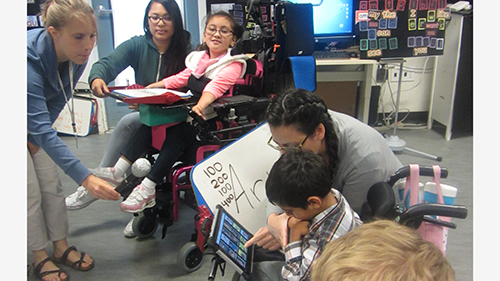
Arjun is learning how to use his speech generating device in order to answer a question during the Jeopardy game. The SLP is modeling how he can respond.
Best, S.J, Heller, L.W., and Bigge, J.L. (2010). Teaching Individuals with Physical or Multiple Disabilities. Boston:Pearson
Soto, G. and Zangari, C. (2009). Practically Speaking. Baltimore: Paul H. Brookes Publishing Co.
California Department of Education. (2014). English Language Arts/English Language Development (ELA/ELD) Framework.
http://www.cde.ca.gov/ci/rl/cf/elaeldfrmwrksbeadopted.asp
Each contribution makes a difference in the lives of our children. Visit our secure donation page and fill out the form to make your secure online donation.

The Bridge School
545 Eucalyptus Avenue
Hillsborough, CA 94010-6404
T: 650-696-7295
F: 650-342-7598
© The Bridge School